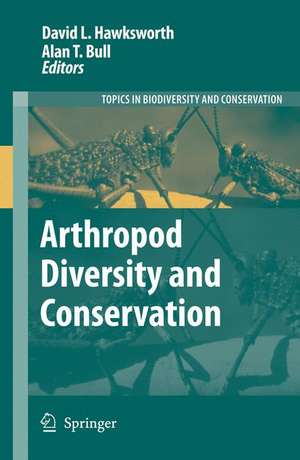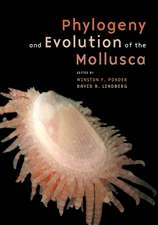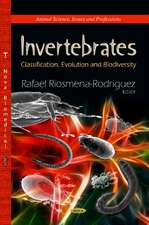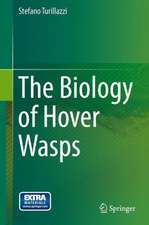Arthropod Diversity and Conservation: Topics in Biodiversity and Conservation, cartea 1
Editat de David L. Hawksworth, Alan T. Bullen Limba Engleză Hardback – 6 sep 2006
This collection of more than 30 peer-reviewed papers focuses on the diversity and conservation of arthropods, whose species inhabit virtually every recess and plane – and feature somewhere in virtually every food web – on the planet. Highlighting issues ranging from large-scale disturbance to local management, and from spatial heterogeneity to temporal patterns, these papers reflect some of the most exciting new research taking place today – and in some of the most biodiverse corners of the planet.
| Toate formatele și edițiile | Preț | Express |
|---|---|---|
| Paperback (1) | 1058.60 lei 38-44 zile | |
| SPRINGER NETHERLANDS – 18 noi 2010 | 1058.60 lei 38-44 zile | |
| Hardback (1) | 1239.49 lei 6-8 săpt. | |
| SPRINGER NETHERLANDS – 6 sep 2006 | 1239.49 lei 6-8 săpt. |
Din seria Topics in Biodiversity and Conservation
- 24%
 Preț: 1605.63 lei
Preț: 1605.63 lei - 18%
 Preț: 947.50 lei
Preț: 947.50 lei - 18%
 Preț: 1218.21 lei
Preț: 1218.21 lei - 18%
 Preț: 942.31 lei
Preț: 942.31 lei - 18%
 Preț: 944.51 lei
Preț: 944.51 lei -
 Preț: 435.38 lei
Preț: 435.38 lei - 15%
 Preț: 646.62 lei
Preț: 646.62 lei - 24%
 Preț: 806.76 lei
Preț: 806.76 lei - 18%
 Preț: 1114.65 lei
Preț: 1114.65 lei - 18%
 Preț: 1126.35 lei
Preț: 1126.35 lei - 18%
 Preț: 1834.27 lei
Preț: 1834.27 lei - 18%
 Preț: 1019.49 lei
Preț: 1019.49 lei - 18%
 Preț: 1236.38 lei
Preț: 1236.38 lei - 18%
 Preț: 1231.47 lei
Preț: 1231.47 lei - 18%
 Preț: 1236.38 lei
Preț: 1236.38 lei - 18%
 Preț: 1230.66 lei
Preț: 1230.66 lei - 18%
 Preț: 1232.71 lei
Preț: 1232.71 lei - 18%
 Preț: 1376.53 lei
Preț: 1376.53 lei - 18%
 Preț: 944.51 lei
Preț: 944.51 lei
Preț: 1239.49 lei
Preț vechi: 1511.58 lei
-18% Nou
Puncte Express: 1859
Preț estimativ în valută:
237.20€ • 257.57$ • 199.25£
237.20€ • 257.57$ • 199.25£
Carte tipărită la comandă
Livrare economică 22 aprilie-06 mai
Preluare comenzi: 021 569.72.76
Specificații
ISBN-13: 9781402052033
ISBN-10: 1402052030
Pagini: 536
Ilustrații: VIII, 525 p.
Dimensiuni: 155 x 235 x 38 mm
Greutate: 1.07 kg
Ediția:2006
Editura: SPRINGER NETHERLANDS
Colecția Springer
Seria Topics in Biodiversity and Conservation
Locul publicării:Dordrecht, Netherlands
ISBN-10: 1402052030
Pagini: 536
Ilustrații: VIII, 525 p.
Dimensiuni: 155 x 235 x 38 mm
Greutate: 1.07 kg
Ediția:2006
Editura: SPRINGER NETHERLANDS
Colecția Springer
Seria Topics in Biodiversity and Conservation
Locul publicării:Dordrecht, Netherlands
Public țintă
ResearchCuprins
Arthropod diversity in Lama forest reserve (South Benin), a mosaic of natural, degraded and plantation forests.- Ecosystem disturbances and diversity increase: implications for invertebrate conservation.- Effects of landscape elements on the distribution of the rare bumblebee species Bombus muscorum in an agricultural landscape.- How ant nests increase soil biota richness and abundance: a field experiment.- Host specificity, alpha- and beta-diversity of phytophagous beetles in two tropical forests in Panama.- Vertical and temporal patterns of biodiversity of fruit-feeding butterflies in a tropical forest in Uganda.- Associations between weevils (Coleoptera: Curculionidea) and plants, and conservation values in two tussock grasslands, Otago, New Zealand.- Effects of management intensity and season on arboreal ant diversity and abundance in coffee agroecosystems.- Influence of habitat fragmentation on the genetic variability in leaf litter ant populations in tropical rainforests of Sabah, Borneo.- Comparing relative model fit of several species-accumulation functions to local Papilionoidea and Hesperioidea butterfly inventories of Mediterranean habitats.- The habitat requirement of the Genji-firefly Luciola cruciata (Coleoptera : Lampyridae), a representative endemic species of Japanese rural landscapes.- Diversity of Chrysomelidae (Coleoptera) in Galicia, Northwest Spain: estimating the completeness of the regional inventory.- Topographic heterogeneity plays a crucial role for grasshopper diversity in a southern African megabiodiversity hotspot.- Landscape effects on the genetic structure of the ground beetle Poecilus versicolor STURM 1824.- The response of ground beetles (Coleoptera: Carabidae) to selection cutting in a South Carolina bottomland hardwood forest.- Factors influencing bug diversity (Insecta: Heteroptera) in semi-natural habitats.- Insect colonisation of fruiting bodies of the wood-decaying fungus Fomitopsis pinicola at different distances from an old-growth forest.- Dragonfly assemblages in arid tropical environments: a case study from western Namibia.- Richness, abundance, and complementarity of fruit-feeding butterfly species in relict sacred forests and forest reserves of Ghana.- Ecological impact assessment of the Aznalcóllar mine toxic spill on edaphic coleopteran communities in the Guadiamar River basin (Southern Iberian Peninsula).- Diversity of the scuttle fly (Diptera: Phoridae) communities in the plantations of moist pine forests of the Bia?owie?a Primeval Forest and the Tuchola Forest (Poland).- Spatial distribution of ground beetles (Coleoptera: Carabidae) and moths (Lepidoptera) in the Mrtvý luh bog, Šumava Mts (Central Europe): a test of habitat island community.- Surrogate habitats demonstrate the invasion potential of the African pugnacious ant.- Impacts of catastrophic earthquakes on the insect communities in estuarine mangroves, northern Taiwan.- Countryside Stewardship Scheme and butterflies: a study of plant and butterfly species richness.- Habitat specificity and variation of coleopteran assemblages between habitats in a Southern African (Swaziland) agricultural landscape.- Effects of habitat disturbance can be subtle yet significant: biodiversity of hawkmoth-assemblages (Lepidoptera: Sphingidae) in Southeast-Asia.- The importance of ants and high-shade management to coffee pollination and fruit weight in Chiapas, Mexico.- Sampling to assess a re-established Appalachian forest in Ohio based on gelechioid moths (Lepidoptera: Gelechioidea).- Diversity patterns of Bornean butterfly assemblages.
Textul de pe ultima copertă
Despite their enormous bulk and complexity of architecture, plants make up only around a quarter of a million of the 8 million or so species on Earth. The major components of biodiversity, instead, are the smaller, largely unseen, silent majority of invertebrates – most of which are arthropods. Vertebrates, a mere blip on the biotic horizon, are elevated in importance in the bigger scheme of things only by the human psyche.
This collection of more than 30 peer-reviewed papers focuses on the diversity and conservation of arthropods, whose species inhabit virtually every recess and plane – and feature somewhere in virtually every food web – on the planet. Highlighting issues ranging from large-scale disturbance to local management, and from spatial heterogeneity to temporal patterns, these papers reflect some of the most exciting new research taking place today – and in some of the most biodiverse corners of the planet.
Edited by David Hawksworth and Alan Bull, with a preface by Michael J Samways, this book will provide a valuable reference to anyone interested in the diversity and conservation of arthropods.
Reprinted from Biodiversity and Conservation 15:1 (2006), excluding the paper by R. O'Malley et al., The diversity and distribution of the fruit bat fauna (Mammalia, Chiroptera, Megachiroptera) of Danjugan Island, Cauayan, Negros Occidental, Philippines (with notes on the Microchiroptera), pp. 43-56.
This collection of more than 30 peer-reviewed papers focuses on the diversity and conservation of arthropods, whose species inhabit virtually every recess and plane – and feature somewhere in virtually every food web – on the planet. Highlighting issues ranging from large-scale disturbance to local management, and from spatial heterogeneity to temporal patterns, these papers reflect some of the most exciting new research taking place today – and in some of the most biodiverse corners of the planet.
Edited by David Hawksworth and Alan Bull, with a preface by Michael J Samways, this book will provide a valuable reference to anyone interested in the diversity and conservation of arthropods.
Reprinted from Biodiversity and Conservation 15:1 (2006), excluding the paper by R. O'Malley et al., The diversity and distribution of the fruit bat fauna (Mammalia, Chiroptera, Megachiroptera) of Danjugan Island, Cauayan, Negros Occidental, Philippines (with notes on the Microchiroptera), pp. 43-56.
Caracteristici
Draws together a wide range of peer-reviewed primary research papers from biodiversity researchers around the world Provides examples from a wide spectrum of issues representing the current state-of-the art in arthropods Provides examples of recent work, usable as case studies for courses in ecology, restoration, biodiversity, conservation Enables specialist researchers to see primary research papers tackling problems in arthropods










